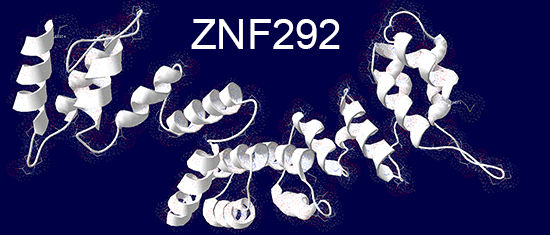 |
HOME CONSERVATION C-TERMINAL ANALYSES DNA AND RNA SEQUENCES RESEARCH QUESTIONS RESULTS RESOURCES REFERENCES |
|
|
|
Protein-Protein interactions
ZNF292 has been proposed to interact with POU1F1 and one or more members of the HP-1 complex. So far no direct interactions have been clearly demonstrated.
GRCh38 shows ZNF292 as being composed of eight exons, the last being much larger than the others and including all 16 zinc fingers. The GTEx Portal shows 14 possible exons, but only the eight identified in GRCh38 show any significant levels of expression. The final exon shows expression levels twice as high any of the other 7 expressed exons suggesting some form alternate splicing. Early studies used a recombinant protein from a cDNA library which included only the last exon which was believed to code for the whole protein. GRCh38 shows only one naturally occurring transcript which is full-length but a computed transcript (exon 6-8) may correspond to the smaller protein. Is the full-length transcript translated and/or are there shorter length alternate transcripts? Is the protein cleaved?
DNA binding Verify the DNA binding site sequence(s) for ZNF292. Lipkin (1993) found ZNF292 zf10-12 bound to a region in the promoter of growth hormone. They used EMSA and ZNF292 fragments or mutants to verify that zf10-12 were involved. They also found a strong binding to the TRE at the promoter of MYH7. They used rat protein and oligos for the experiment. Repeat experiment using human ZNF292/oligos. ChIPSeq has been attempted on ZNF292 using GFP conjugated protein in HEK cells. The results (ENCODE) are unsatisfactory in that the two experimental trials show very little overlap. We should try again using native protein with an anti-ZNF292 antibody and a cell line more likely to be expressing higher levels of ZNF292.
Expression What cell types express ZNF292 in the the brain? Specifically in the cerebellar cortex and hippocampus?
A role in cell-type maintenance and epigenetics? ZNF292’s closest paralog RLF has been shown to maintain CpG shores hypomethylated in a subset of promoters. ZNF292’s N-terminal is highly similar to that of RLF, but it’s zinc fingers vary considerably. Does ZNF292 perform a similar function in a different set of promoters? ILC3 cells in ZFP292-/- mouse mutants have been found to be largely missing. The mutants appear to be viable however.
Effect of Protein Truncating mutations Do some nonsense or frame-shift mutations escape nonsense mediated decay allowing the translation of a potentially deleterious truncated protein?
|